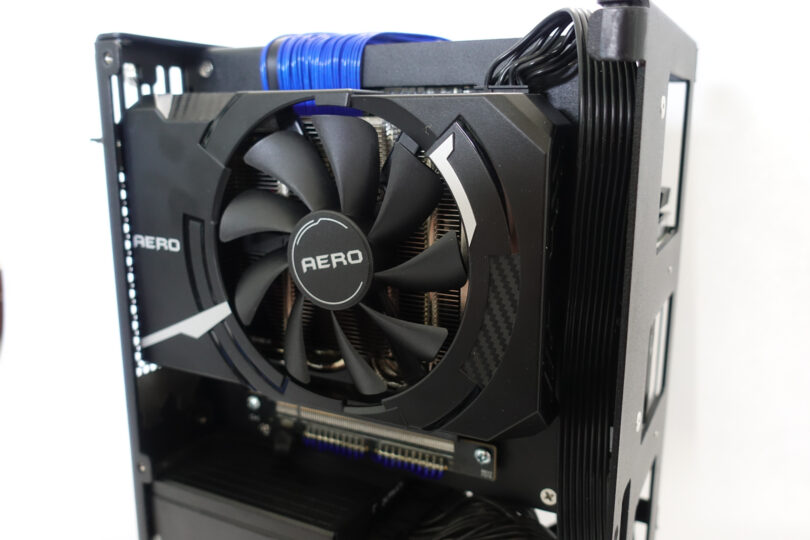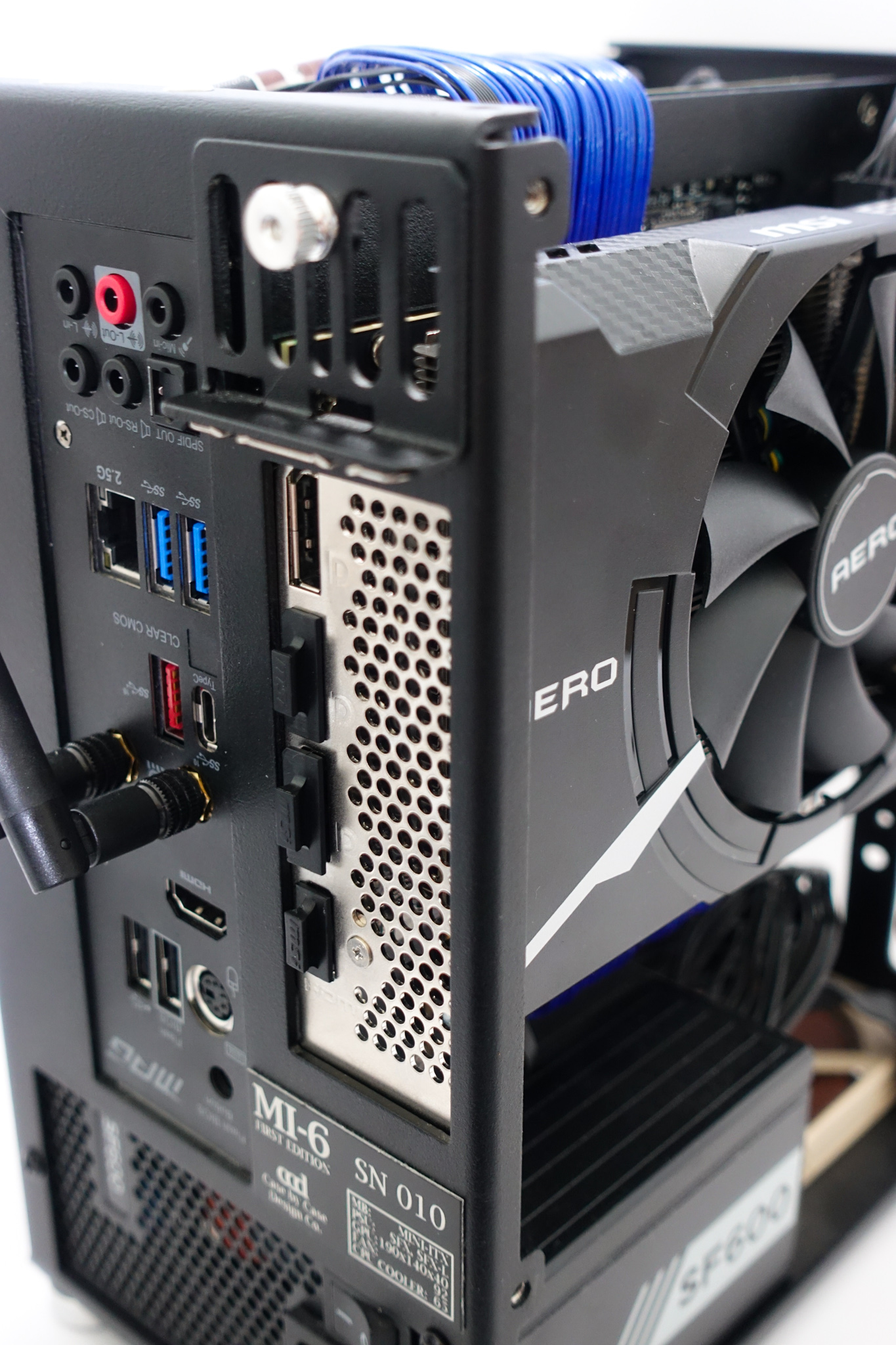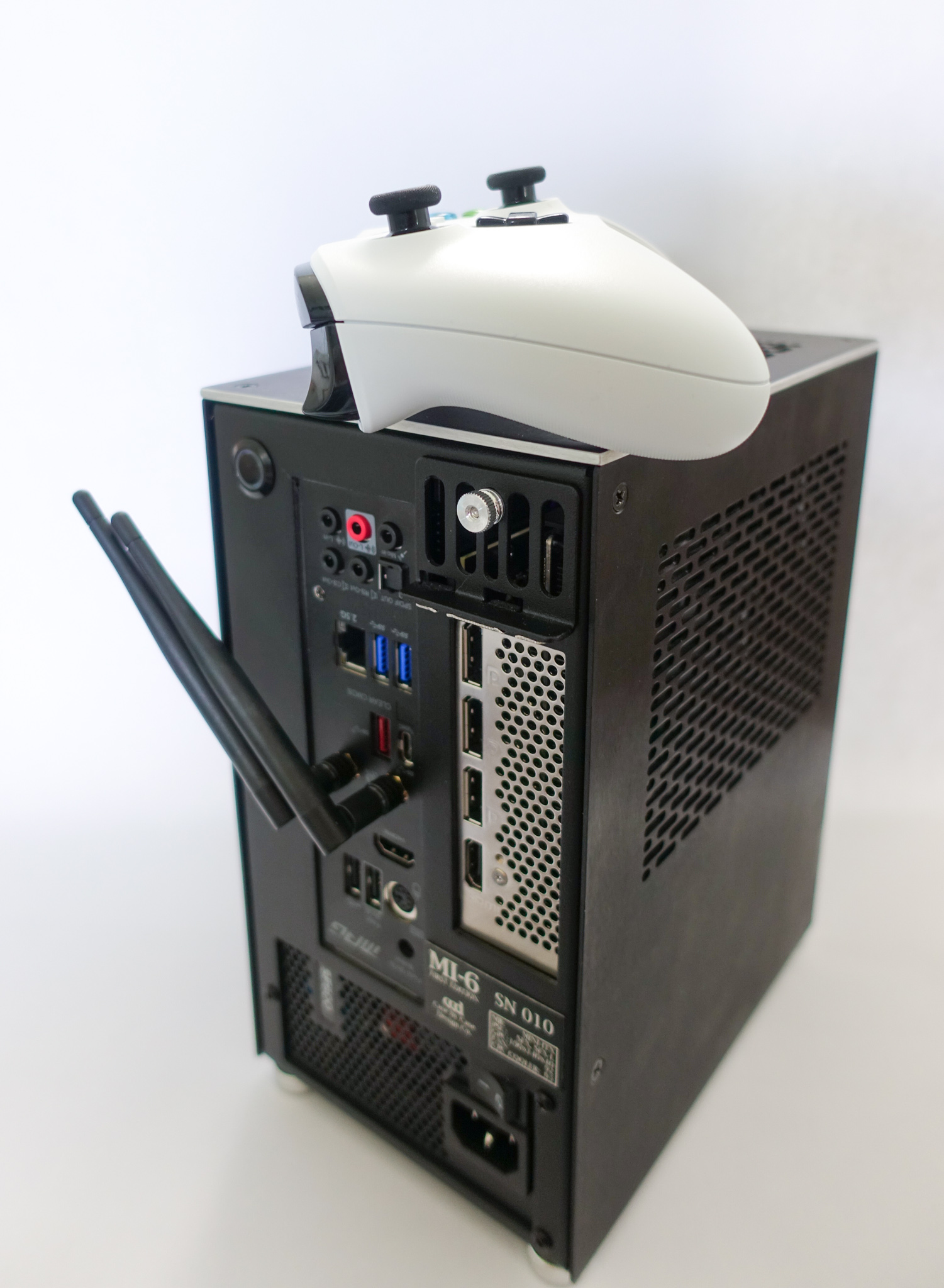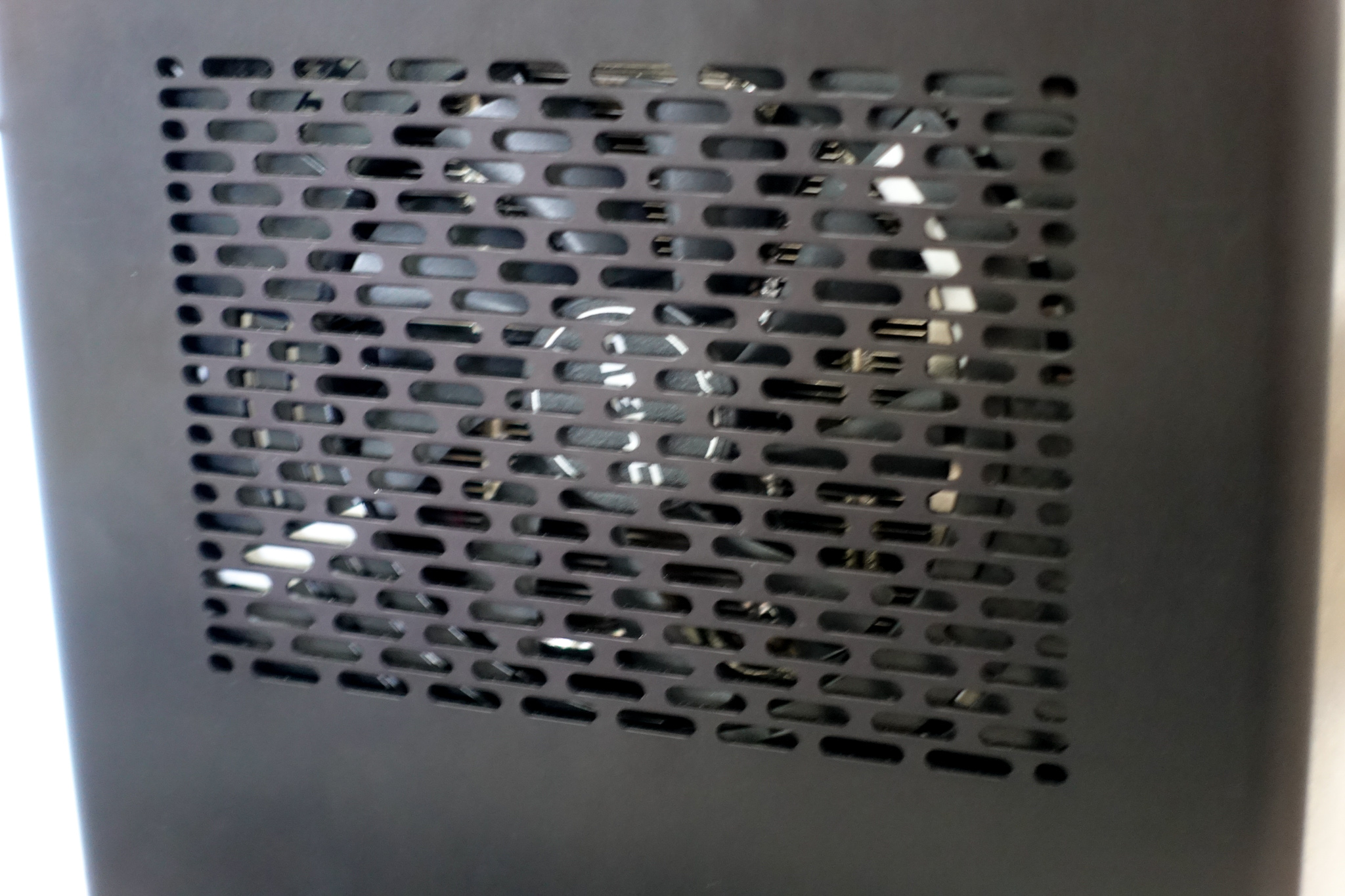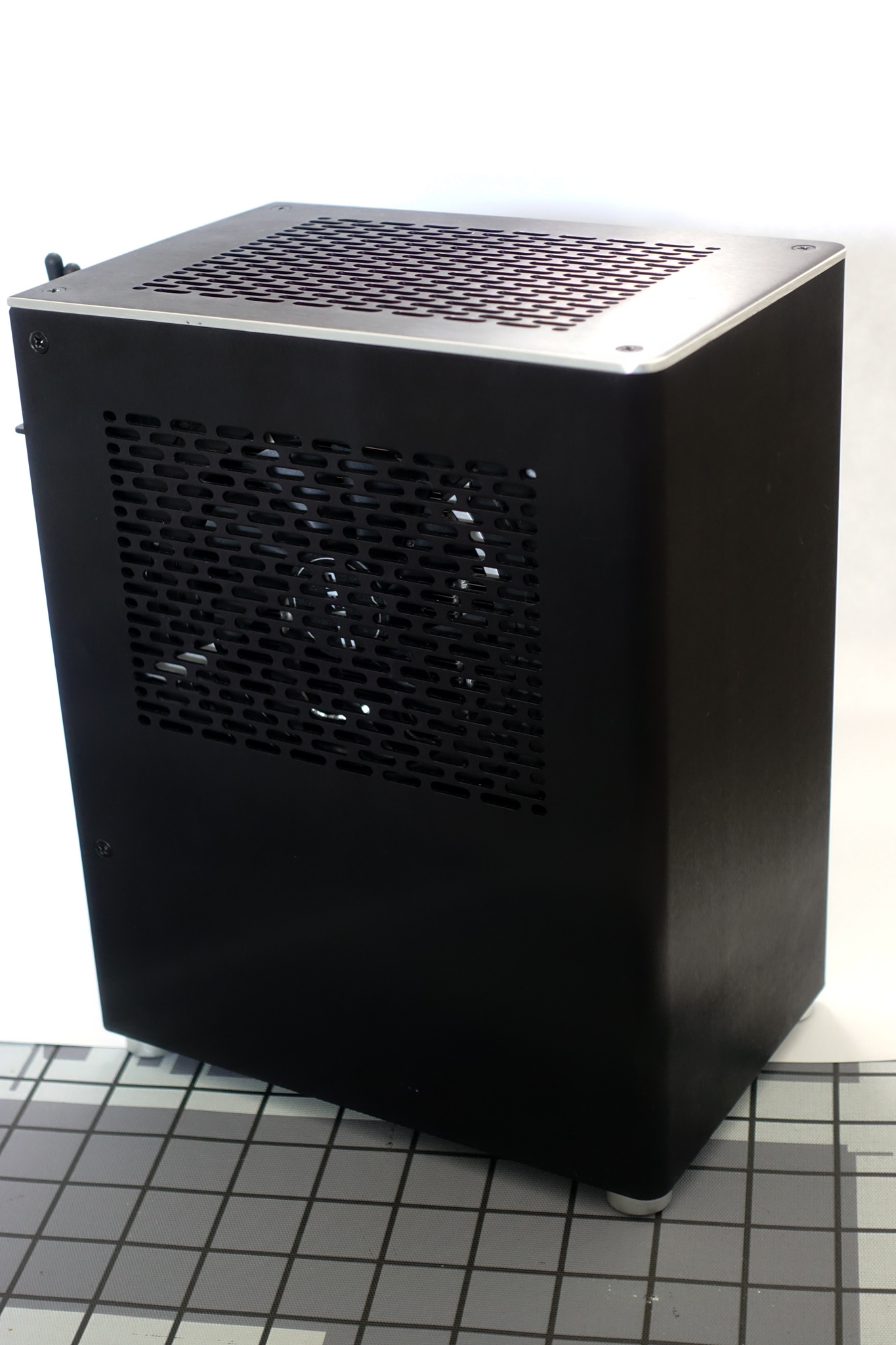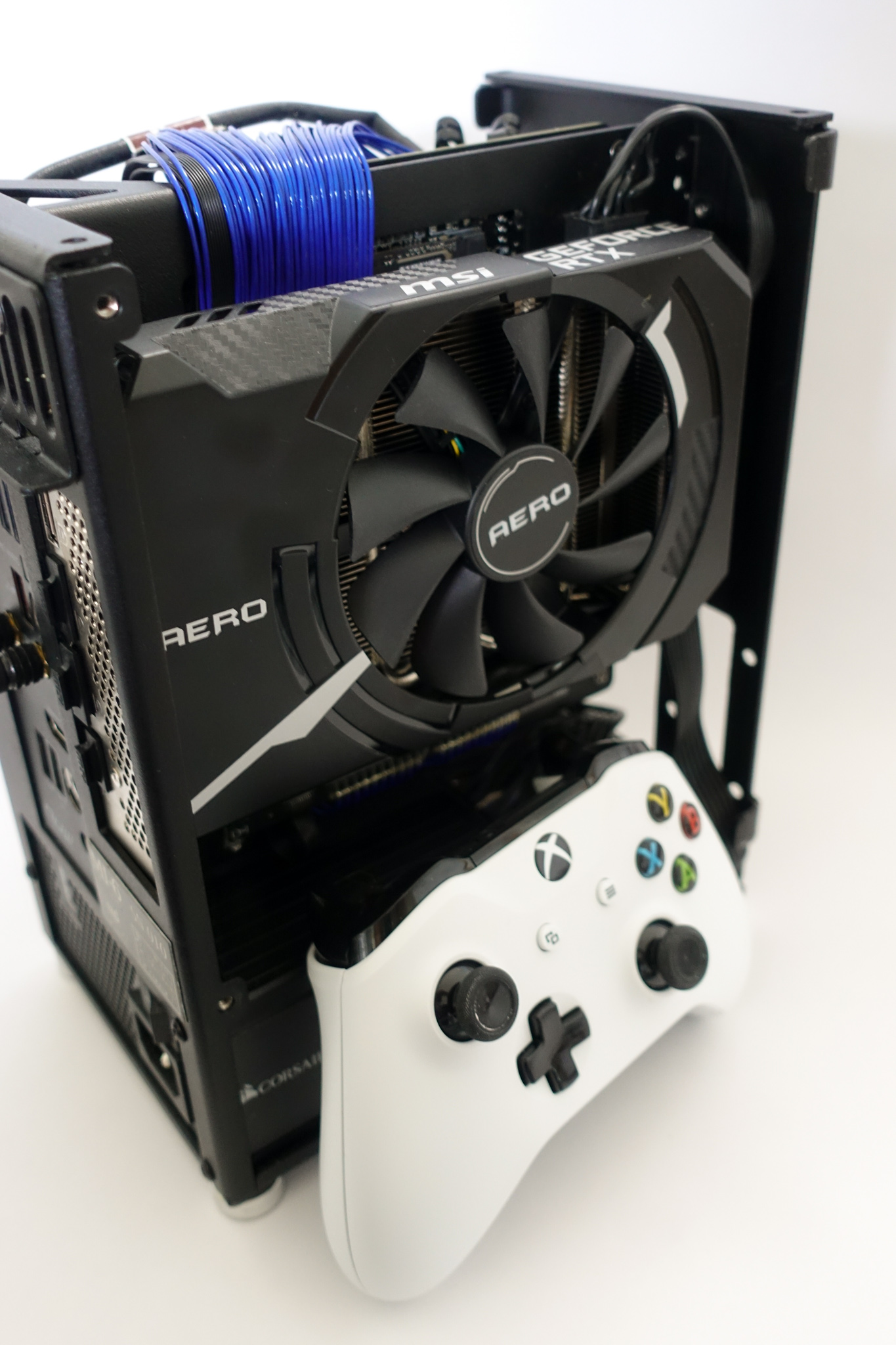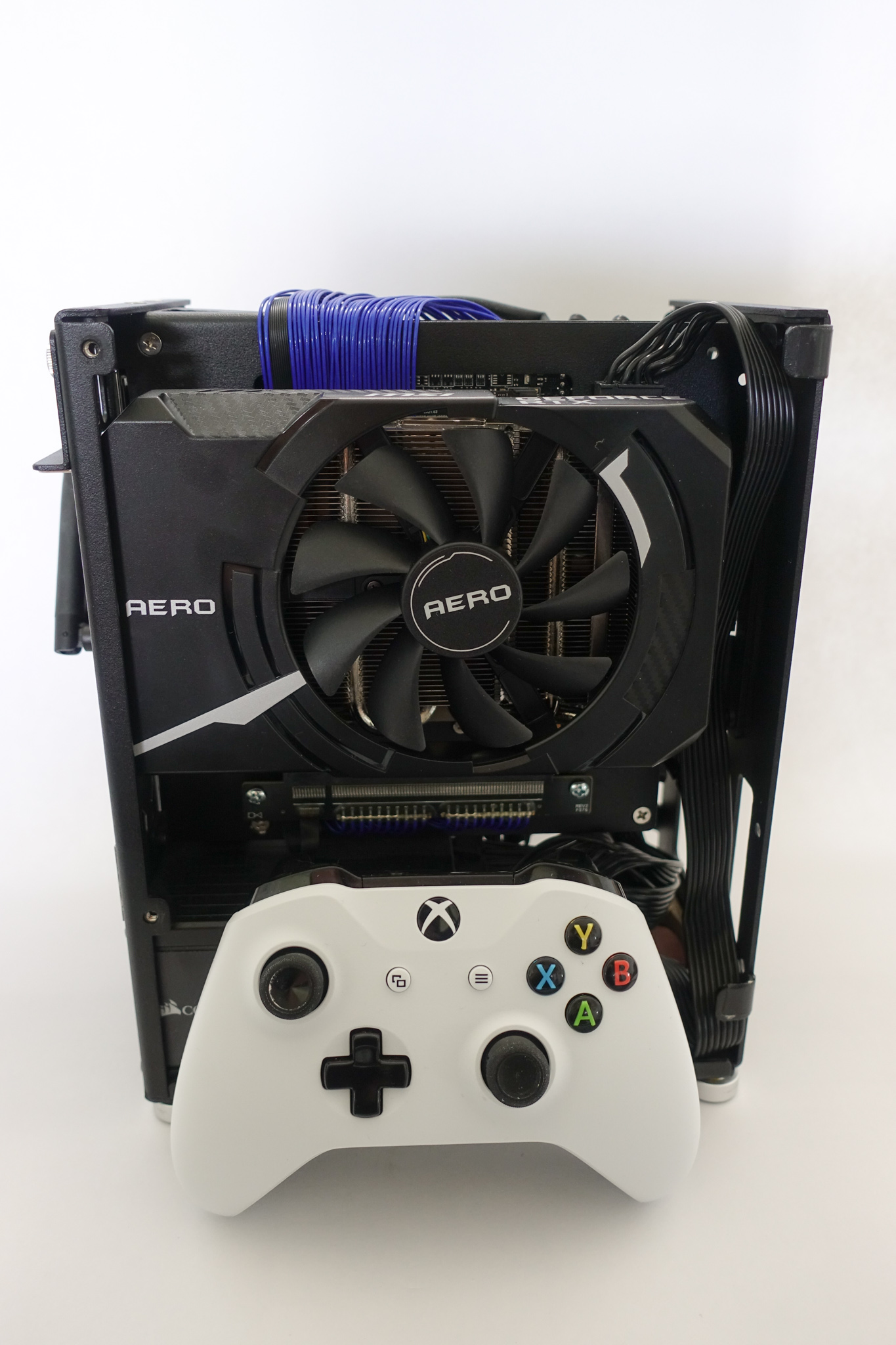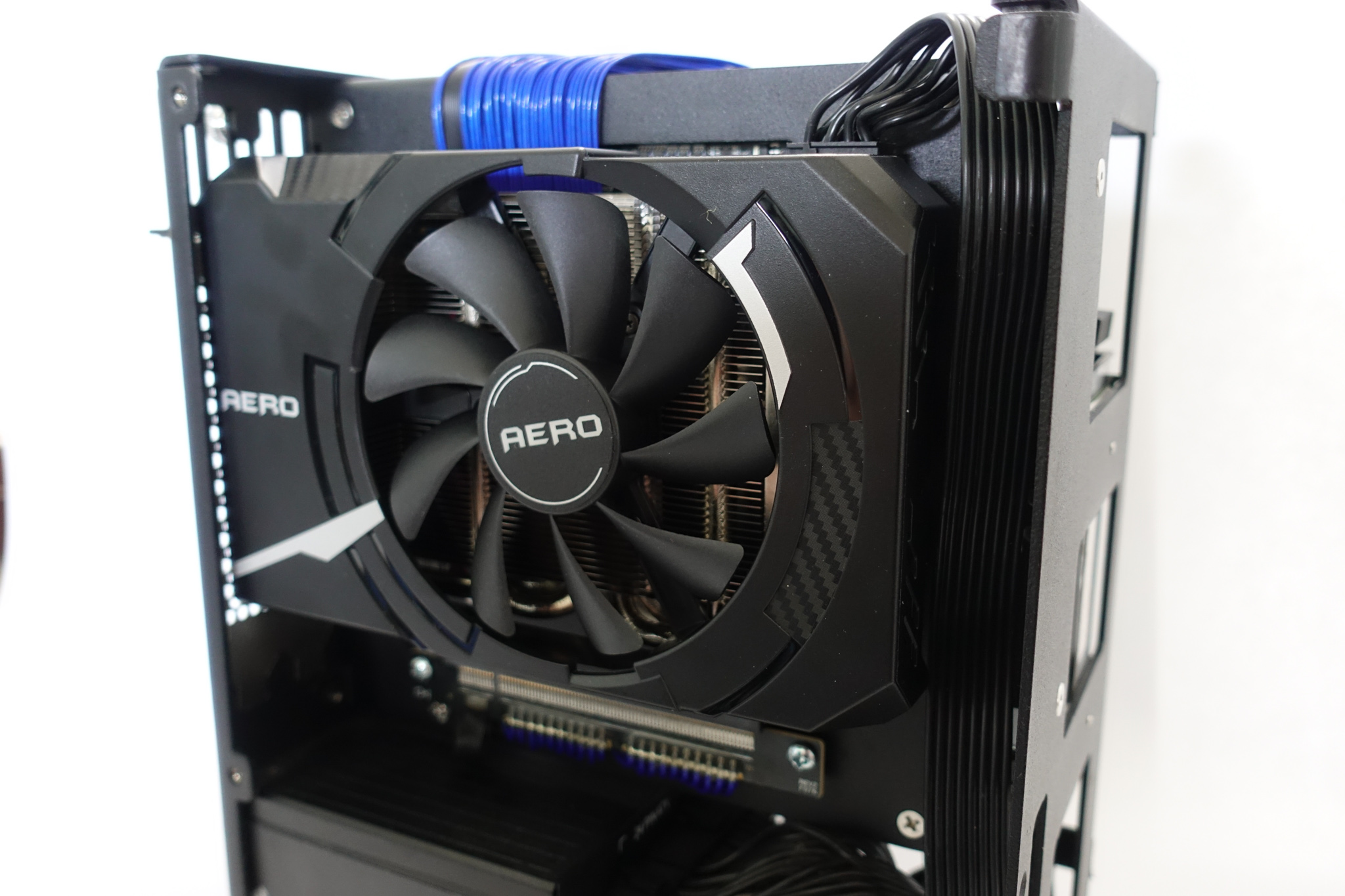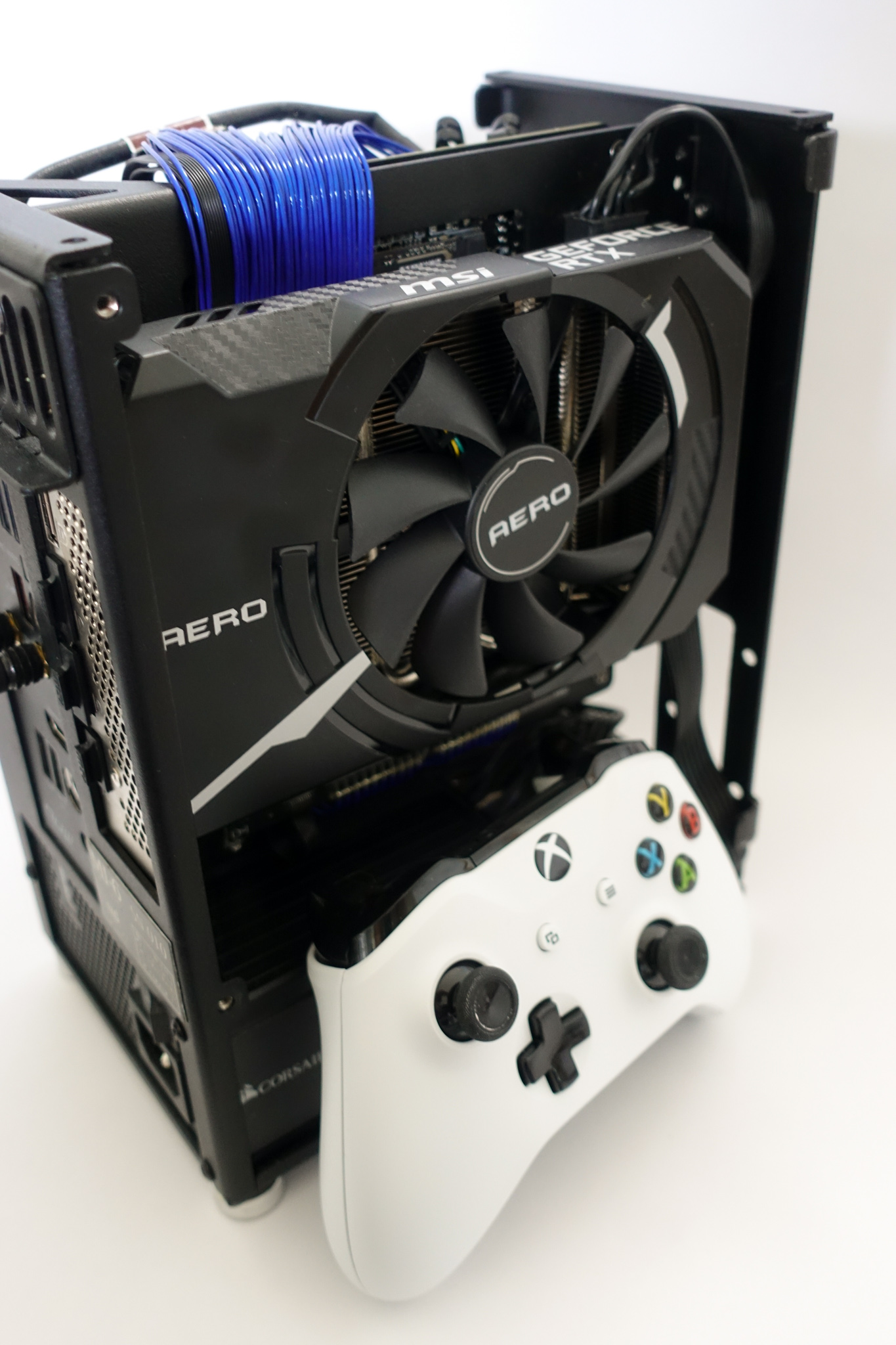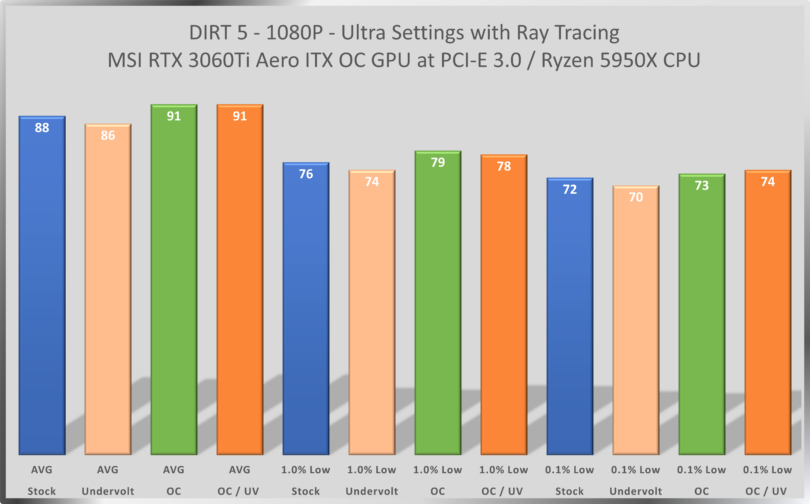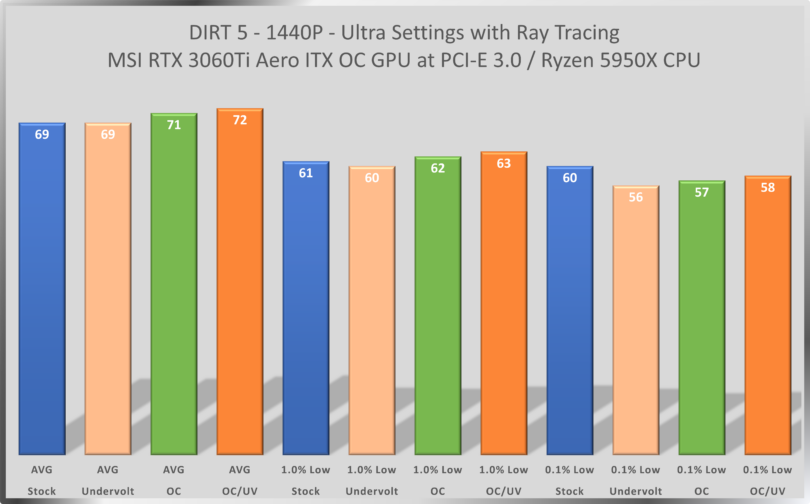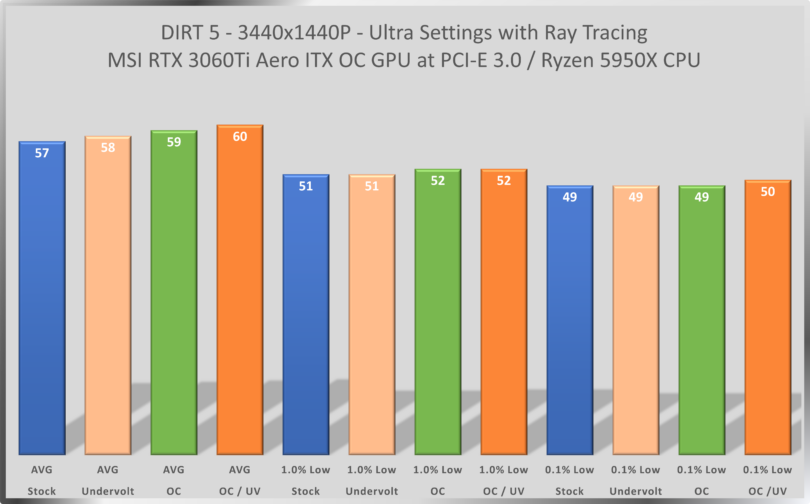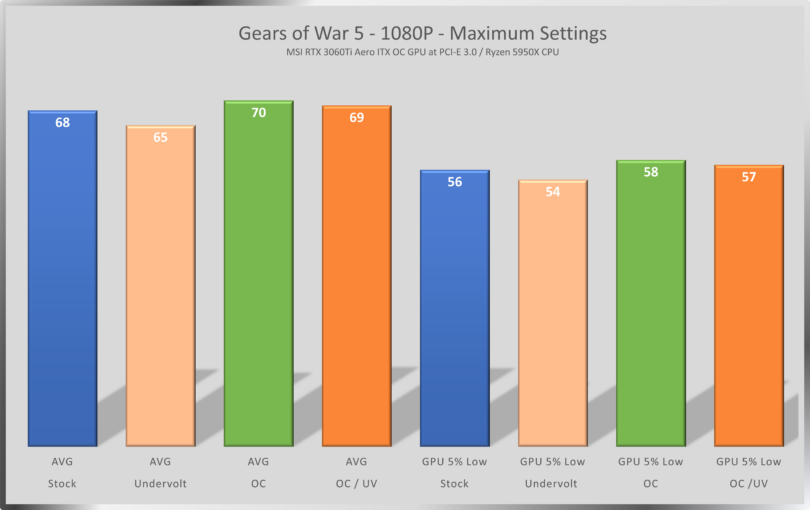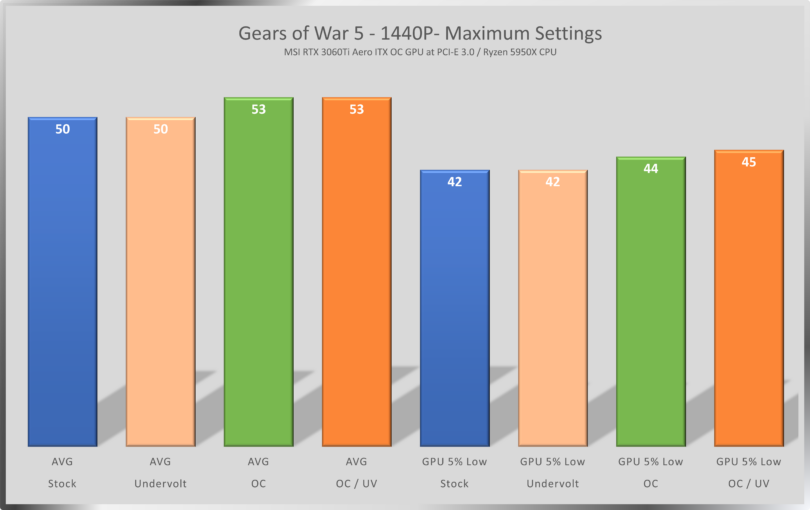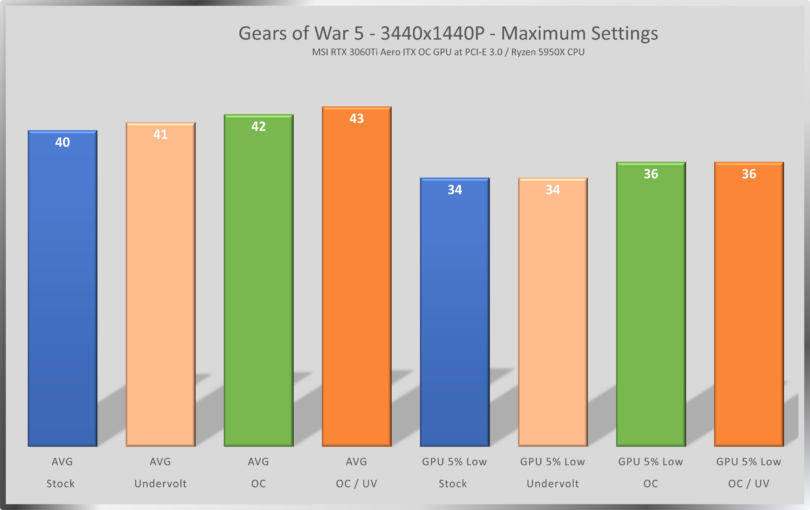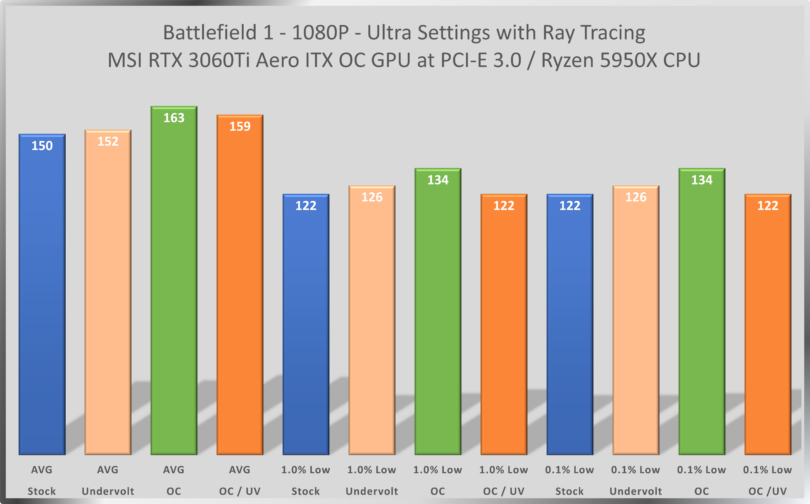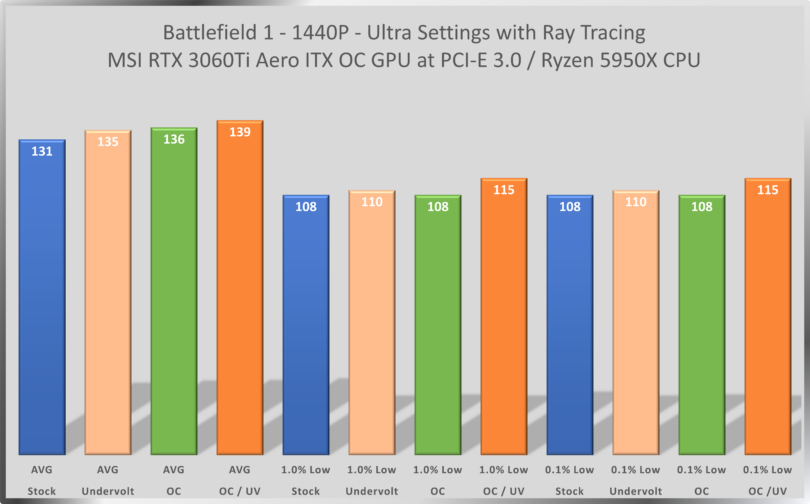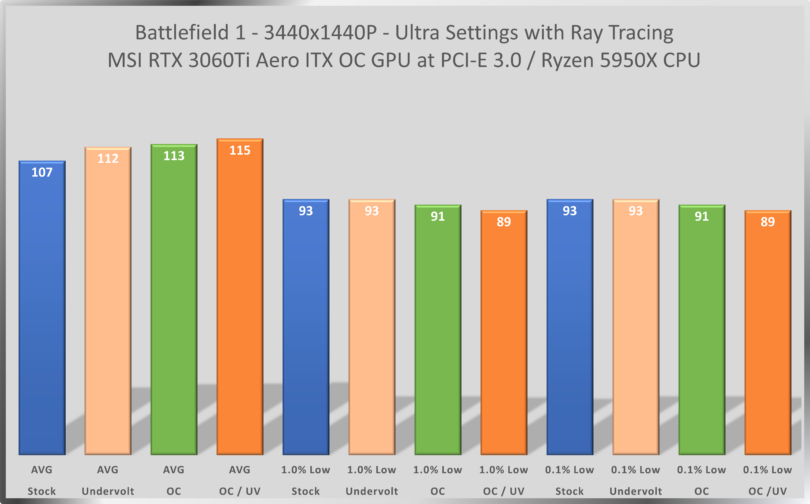If you’ve been following our coverage of the MSI RTX 3060 Ti then you know that one of the few issues we had was that the single axial fan could get pretty loud when at full load. While gaming,the fan was spinning at about 2700RPM or over 80% of it’s max performance. This resulted in a 13dBA rise over ambient, and a temps in the 78C to 80C range. The question then is what can we do about the noise, and is there any room to overclock?
Overclocking and Undervolting
For these benchmarks we set up four scenarios.
1. Stock clocks and stock fan control.
2. Undervolt set to 850mV at 1815MHz core clock with a custom fan speed curve.
3. Overclock of +150 core and +800 VRAM with stock fan control.
4. Undervolt and Overclock with a 1935Mhz at 915mV.
The stock setup is just that; stock. The card manages itself entirely with no interference. This is how it was tested in the initial review. Typically, the card’s core clock would fluctuate from the high 1600MHz range up to the high 1800s.
The undervolt test was designed to try to get the card to behave as quiet as possible, without loosing performance. In this case, a stable balance was of 1815MHz at 850mV was the sweet spot. The fan turned at roughly 1700 to 1800RPM on a manual fan curve.
For the overclock, the core voltage was left alone, but a simple +150 was entered into the core and +800 for the memory.
Finally, the undervolt while overclocking (aka OC/UV)required numerous test runs but eventually a stable 1935MHz at 915mV was achieved. Stock fan curve was used.
Test Setup
Our test setup was the same system we’ve been using:
- CCD MI-6 Gen 1 Small Form Factor Case
- MSI MPG B550I Gaming Edge Wifi Motherboard
- Louqe Cobalt RC260 TwinAX Gen4+ PCI-E 4.0 Rise Cable.
- Ryzen 5950X CPU with PBO Undervolt of -15 all cores.
- 32GB DDR4-3200 Corsair LPX Dual Rank / Dual Channel memory at 16-18-18-36 timings.
- Samsung 1TB 980PRO NVME SSD
- Corsair 600 Watt Gold SFX PSU with stock cables.
Testing Methodology
- All benchmarks except Battlefield 1 were run three times, averaged, and rounded as appropriate.
- Battlefield 1 was run on a 64 player conquest match. Measurements were taken using Fraps. Each resolution had the same character, class, level, starting points, and were as similar as possible.
- Programs running were the game being tested, the games service provider (Ex. Steam or GOG), GeForce Experience, and any stock programs that a clean install of Windows 10 Professional includes.
- Games were tested at their absolute maximum detail settings.
- Ray Tracing was turned on if available.
- In game benchmarks were used for consistency. There were no live gameplay benchmarks in these tests.
- BIOS was set to PCIe 3.0 for the GPU.
- As this is a mid-range GPU, resolution testing was limited to common mid-range resolutions. They are 1080P, 1440P, and Ultrawide 3440x1440P.
- The game’s default Direct X API settings were used except where noted.
Performance Results
Dirt 5
At 1080P there was a 3.35% improvement in the average frame rate for the OC and OC/UV settings, while seeing a 2.30% loss for just the undervolt. There was a better performance gain for the 1% lows moving from 76FPS to 79 FPS for the OC yielding a 3.87% improvement. The 0.1% lows saw a small improvement.
Between the undervolt and the OC there was a 5.65% difference in performance.
AT 1440P there was a 4.26% difference between stock clocks and the OC/UV. This was reduced to 3.23% for the 1% lows, and actually saw a deficit in the 0.1% lows. The UV performed well in the AVG and 1.0%, but struggled in 0.1% lows with a 6.9% loss in performance vs stock.
Moving to 3440 x 1440P Ultrawide, we see a consistent rise in performance above stock as we move from undervolting to OC/UV, with a 5.13% spread in performance. The 1% and 0.1% lows were one only a single FPS difference which is basically margin of error.
Gears of War 5
Gear of War 5 at 1080P saw the greatest rise in performance with the straight OC with a 2.9% improvement in average frame rates, and a 3.51% performance increase in 5% low performance. Conversely, the undervolt settings saw a loss of 4.51% in the average frame rate, and 3.64% in the 5% low when compared to stock. The difference between the OC and undervolt in average FPS was a large 7.41%. This translated to a difference was 70FPS for the OC and 65FPS for the undervolt.
At 1440P, the average frame rate rises from 50 to 53FPS when comparing stock to OC and OC/UV, for a 5.83% improvement in performance. 5% Low numbers echoed this. Undervolt scored identically to stock.
3440 x 1440P Ultrawide showed the largest spread between the four test settings with a 7.23% increase in performance between stock and OC/UV. The 5% Low saw a 5.71% performance differential between stock and OC and OC/UV. The undervolt performed at or above the stock settings while being substantially quieter and cooler.
Battlefield 1
Note: Due to the way Fraps records framerate, the 1% low and 0.1% low will be identical.
Battlefield 1 at 1080P saw a strong 8.31% increase in average frame rates between stock and OC, and a 9.38% improvement in the 1% low. The undervolt performed on par with the stock settings.
At 1440P there was a reduced improvement vs 1080P. There was a 5.93% improvement between stock and OC/UV settings, while undervolt and OC performed almost identically to each other.
At 3440x1440P Ultrawide, we again see the OC/UV leading the charge with a 7.21% improvement in performance over stock average framerates, but a degredations of 1% lows by 4.4%. The degradation appears to be similar to Dirt 5 at 1440P.
At this point, we have established a pattern. The Aero 3060 Ti can overclock and get a decent uplift of 4 to 8% depending on the game. Conversely, focusing on undervolting to get a quiet card leaves the performance sometimes slightly above and sometimes slightly below stock. Undervolting while Overclocking can yield better results than an OC by itself, but can also effect minimum frame rates depending on the game.
Noise and Thermals
The big winner for noise is the undervolt. The stock and OC settings saw a 13dBA rise over ambient. The undervolt measured at just 6dBA over ambient. Given, I don’t have the quietest noise floor to test with, but the perceived sound difference was substantial and very noticeable. The Aero 3060 Ti’s fan turned in the 1700RPM range with the undervolt, while it screamed upward of 2700 RPM for the stock and OC settings. Moreover, while the stock card would rise to 78C on average, the undervolt ran a cool 74 to 75C in my testing. The OC pushed upward of 80C.
The undervolt with overclock should be the best of both worlds then, right? Not exactly.
While the OC/UV did produce lower noise and fan speed, it didn’t lower it by much. Moreover, while the fan did spin at 2500RPM instead of 2700RPM, it was still higher pitched and far more noticeable.
Conclusion
My biggest concern during the initial review was that the Aero 3060 Ti was loud. The undervolt substantially reduced the noise from the card, while also still giving + or – 3% of the stock performance. In my book, that’s the best bang for the buck as I can hear the OC and and UV/OC through my closed-back headset.
If speed is your only concern, I would suggest the set-and-forget OC over the OC/UV. While the OC/UV has the potential to be faster, cooler, and quieter, the difference isn’t that large on any of those fronts. Moreover, it will take a substantial amount of time to find the perfect balance of power, clock speed, and fan RPM. If you enjoy squeezing every last drop of potential out of your hardware though, go for it.
What I don’t suggest is leaving the card stock. It’s just as loud at OC as it is at stock so there is no loss there. Plus you get improved performance.
However, that’s just my opinion. What do you think? We’re all hardware enthusiasts and want to have a great and helpful community. Drop by our forums or Discord to chat with our members and staff, even if you don’t own a small form factor PC.

